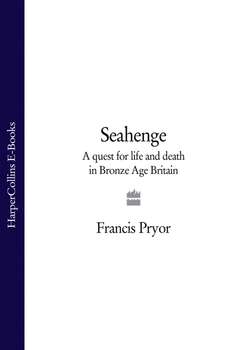Читать книгу Seahenge: a quest for life and death in Bronze Age Britain - Francis Pryor - Страница 6
PLATES
Оглавление(Unless otherwise stated, all photographs are from the author’s collection)
PLATES SECTION 1
The prehistoric landscape at Fengate, Peterborough. The Bronze Age fields were used by livestock farmers between 2500 and 1000 BC.
Unexcavated Bronze Age droveway ditches at Fengate, showing on the stripped gravel surface as dark marks.
The bank that ran alongside a Bronze Age ditch at Fengate was preserved beneath upcast from a modern drainage dyke.
A minor Bronze Age double-ditched droveway being excavated at Fengate.
Body of a young man buried at Fengate sometime between 3500 and 3000 BC.
Gold objects from Barrow G.8 at Wilsford, Wiltshire (2000–1800 BC). (Wiltshire Archaeological and Natural History Society)
Gold grave-goods from a barrow at Little Cressingham, Norfolk (2000–1800 BC). (Norfolk Museums and Archaeology Service)
Sheet-gold cape found at Mold, Flintshire, Wales in 1833. It covered a body which lay under a cairn in a gravel pit (2000–1800 BC). (British Museum)
The Carnac alignments, erected near the coast in Brittany during the Late Neolithic period, around 3500 to 2500 BC (The Ancient Art & Architecture Collection)
The aerial photograph which first revealed the faint cropmarks of the Etton causewayed enclosure (3800 BC). (Photo: S.J. Upex)
Corn-grinding stone, or quern, buried on-edge in the Neolithic causewayed enclosure at Etton (3800 BC).
Aerial photograph taken by J.K. St Joseph in July 1951, showing cropmarks south of Maxey church, Cambridgeshire. (© Crown Copyright 1951/MOD. Reproduced with the permission of the Controller of Her Majesty’s Stationery Office)
The immediate effects of de-watering on waterlogged Neolithic wood (3800 BC) at Etton.
The base of a Bronze Age notched log ladder (1000 BC) found at the bottom of a large quarry pit at Fengate.
The notched log ladder from the Fengate quarry pit.
A notched log ladder in the courtyard of a disused Tibetan Buddhist temple in the Himalayas north of Kathmandu, Nepal. (Photo: Felix Pryor)
Reconstruction of the first Bronze Age roundhouse (c.1500 BC) to be found at Fengate.
Skeleton of a young woman found at Fengate and radiocarbon dated to 3030–2500 BC.
Bronze Age weapons (1300–900 BC) from Flag Fen.
Bronze Age wheel found at Flag Fen, dating to about 1300 BC.
Middle Bronze Age stone roadway (1200–1300 BC) at Yarnton, Oxfordshire.
Clothes of a young Middle Bronze Age woman (1400–1200 BC) found in a barrow at Egtved Farm in southern Jutland, Denmark. (Danish National Museum)
PLATES SECTION 2
John Lorimer holds the bronze axe that started the Seahenge saga.
A view along the Holme-next-the-Sea peat beds at low tide, autumn 1998, showing the timber circle.
The team from the Norfolk Archaeological Unit start working on the ground-plan of the Seahenge timbers.
A close-up of the post circle, showing the eroded and damaged state of the timbers.
The initial exploratory trench within the circle of timbers, autumn 1988.
Part of the inverted oak tree exposed by the excavation.
A post being prepared for removal.
The team’s soil scientist, Dr Fran Green, records the precise position of sample tins placed in the section on either side of a post.
A group of Druids occupy the central tree in an attempt to prevent its removal.
PLATES SECTION 3
Sheets of foam being attached to the central tree to cushion the straps which would be used to lift it.
The lifting of the central oak tree.
The tree trunk was carefully checked when clear of the ground, in case any votive offering or other unexpected find might still be adhering to it.
Members of the Norfolk Archaeological Unit preparing to lift the final two timbers of the Seahenge circle.
The central tree in a shallow water bath at Flag Fen.
The flat underside of the central oak tree was found to be covered with axe-marks, believed to be the earliest left by a metal tool yet found in Britain. One of the towing loops, still with honeysuckle rope in place, is also visible. (Photo: F. Pryor. Courtesy of English Heritage)
One of the Seahenge timbers being carried to the washing tanks at Flag Fen.
Wide axe-marks, similar to those on the central oak tree, were also found on the lower, chopped ends of the oak posts of the timber circle. (Photo: F. Pryor. Courtesy of English Heritage)
The freshly de-barked oak-tree stump with one of the two towing loops and a length of twisted honeysuckle rope ready for the reconstruction of a full-size replica of Seahenge by Channel 4’s Time Team.
The Time Team reconstruction reaches a critical stage, with the oak tree poised above the hole dug to receive it.
The roots of the central oak are levered upwards, and the two-ton tree drops into position.
The tree is manhandled upright.
Aerial view taken during the final stages of the reconstruction.
The interior during the reconstruction.
Excavators working on the Bronze Age religious site at Flag Fen.
An archaeologist reveals part of a wooden axle which had been jammed between two large posts at Flag Fen.
The oak axle from Flag Fen (1200–1300 BC), the oldest known axle found in Britain.
Objects thrown into the waters around the Flag Fen posts as offerings to the gods and ancestors.
A later Iron Age village at Cat’s Water, Fengate, dating to the final three centuries BC.
